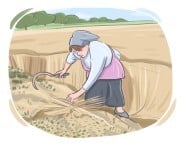to cut and collect a crop
ACT Science - Agriculture and Forestry
Here you will learn some English words related to agriculture and forestry, such as "hypha", "millet", "deciduous", etc. that will help you ace your ACTs.
review
flashcard
spelling
quiz

to grow plants or crops, especially for farming or commercial purposes
a chemical or natural material that is added to the soil to improve its productivity and help plants grow
the artificial application of water to land or soil to assist in the growing of crops and the maintenance of landscapes
the amount of water falling to a particular location over a specified period
(of a farm or an industry) to grow or produce a crop or product
characterized by receiving very little rainfall, often with erratic precipitation patterns and a tendency towards drought conditions, but not as extreme as arid climates
relating to trees with hard and dry fruits called cones and needle-shaped leaves
the practice of cultivating and managing forests, including the planting, growth, and harvesting of trees for timber production and ecosystem maintenance
an agricultural system where landowners allow tenants to use the land in exchange for a share of the crops produced
to use a large farming equipment to dig the ground and make it ready for farming
a farming approach that uses technology to optimize crop production by precisely managing resources like water, fertilizer, and pesticides
a farming system that combines agriculture with livestock grazing, where both activities are practiced on the same land
(of food or farming techniques) produced or done without any artificial or chemical substances
a chemical substance or agent that is used to kill or control insects that can cause harm to humans, crops, animals, and structures
a type of chemical substance that is used for killing insects or small animals that damage food or crops
to create stepped levels or flat areas on sloped land to prevent erosion and make the land suitable for farming or forestry
to break up the surface of the ground, remove weeds, etc. using a gardening tool with a thin metal blade attached to a long handle
to prepare the soil for planting by digging, stirring, or turning it over using a tool such as a plow or a tiller
a chemical substance that kills plants, used for destroying plants that are not wanted
solid waste from animals spread on a piece of land to help plants and crops grow healthier and stronger
decayed leaves, plants, or other organic waste turned into a mixture that can improve the soil's quality and productivity once added to it
to rid a garden or other area of land of unwanted plants
a protective layer of decaying leaves or compost that is spread over or around a plant to improve the quality of the soil, stop weeds from growing, or to provide protection for the plant's base and its roots
to deliberately mate individuals of different breeds or varieties to produce offspring with desirable characteristics or traits
a plant disease that causes withering, discoloration, or death without immediate rotting
the presence of large numbers of harmful insects, pests, or other organisms in an area, often causing damage to crops, trees, or natural environments
related to agriculture, farmers, or rural life
a method of growing plants without soil, using nutrient-rich water solutions
the excessive nutrients in water causing algae blooms, oxygen depletion, and ecological problems
small seeds of a large crop that grows in warm regions, used to feed birds or make flour
a tall plant growing in Central America that produces yellow seeds, which are used in cooking
a group of edible plants that are typically harvested and cooked while still immature
a plant with bright orange or yellow flowers that produces seeds rich in oil
the flower head of a plant from the cabbage family that is white in color and is eaten as a vegetable
a young plant that develops from a seed, typically in the early stages of growth after germination
aquatic plants with finely divided underwater leaves, found in freshwater habitats like lakes and ponds
a deciduous tree known for its smooth bark, typically found in temperate and boreal forests
the process by which water on the ground surface enters the soil, replenishing soil moisture and reducing runoff
the layer of decomposing organic matter, such as leaves, twigs, and other plant material, that accumulates on the soil surface
a thread-like structure found in fungi, consisting of a chain of cells that collectively form the fungal mycelium, essential for nutrient absorption and growth
small animals or insects that are believed to be destructive and are difficult to handle when they appear in a considerable number
a barren area of land that is unsuitable for agriculture or habitation
a type of fruit belonging to the Cucurbitaceae family, typically with a hard outer shell, often used for containers, utensils, or as ornamental decorations
an edible root of red color with a pungent taste that is eaten raw in salads
a tall evergreen tree with fine-grained wood, valued for construction and known for its dense foliage
any type of plant whose pods contain seeds, such as peas and beans
a succulent herb with fleshy leaves, commonly used in salads and culinary dishes



























